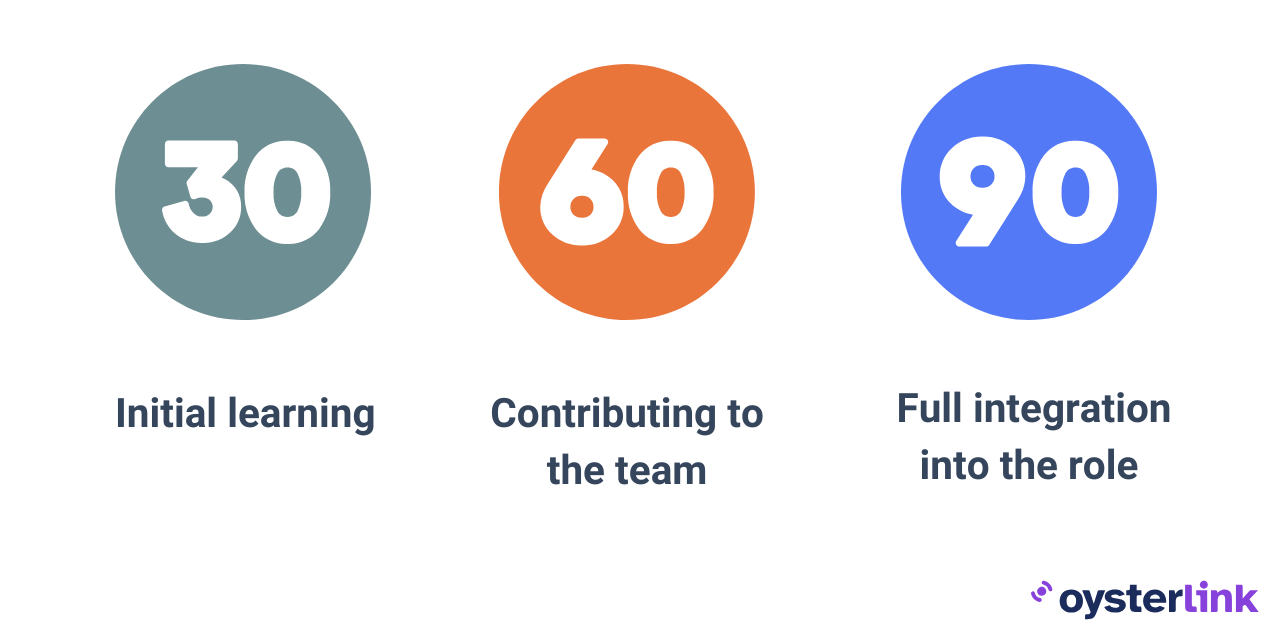It typically takes a new hire five to eight months to reach full productivity: a timeline that may frustrate employees and managers alike. The solution? A well-structured 30-60-90 day plan that puts you on the fast track to success.
The numbers speak for themselves. Professionals who follow a clear action plan double their chances of hitting first-quarter performance targets. However, many talented employees struggle to create an effective roadmap that truly showcases their capabilities.
This practical guide walks you through building a 30-60-90 day plan that will help boost your career growth. You'll learn the exact steps to set meaningful goals, track your progress and create lasting results.
What Is a 30-60-90 Day Plan?
A 30-60-90 day plan serves as your strategic roadmap for success in a new role or project. This structured approach breaks down your first three months into manageable phases, each with specific goals and measurable outcomes.
Key Components of the Plan
The foundation of an effective 30-60-90 day plan rests on four essential components:
- Learning goals: Focus on acquiring new skills and understanding company processes.
- Performance goals: Set specific metrics to demonstrate improvement. Also, identify opportunities to contribute beyond basic responsibilities.
- Personal goals: Build relationships and integrate into company culture.
Each component works together to create a comprehensive framework for professional growth. Additionally, these elements help you stay focused on both immediate tasks and long-term objectives while maintaining a balanced approach to your development.
Why You Should Have a 30-60-90 Day Plan
A well-structured plan accelerates your path to full productivity. Consequently, you establish clear expectations with your manager from day one, ensuring alignment on priorities and goals.
The plan provides a framework for measuring progress through specific, quantifiable objectives. This systematic approach helps you track improvements and adjust strategies when needed.
The structured nature of the plan demonstrates your proactive mindset to leadership. By showing initiative in planning your success, you position yourself as a thoughtful and organized professional who takes ownership of their development.
Structure of the 30-60-90 Day Plan
A successful 30-60-90 day plan needs well-defined goals for each phase. You should think over learning curves, performance metrics and opportunities to grow.

Let's look at specific objectives for each phase that will help maximize your effectiveness.
First 30 Days: Learn and Observe
The 30-day mark is your initial learning phase, where you absorb essential information about your role and company operations. During this period, you function as a "sponge," soaking up knowledge about processes, expectations and team dynamics.
That said, you need to study your company's mission, vision and overall strategy. This helps you understand how your role fits into the bigger picture.
Meet with your team director to see how your goals will drive business growth. Beyond the technical aspects, dive into the company's culture code. This will help you learn organizational values and how they work in practice.
Performance metrics for this phase include:
- Complete new hire training with 90% or higher scores.
- Study customer personas and target audience profiles.
- Become skilled at core tools and processes.
- Schedule introductory meetings with the core team.
Days 31 to 60: Start Contributing
The 60-day timeframe marks your transition from learning to contributing. Specifically, this is where you’ll apply your newfound knowledge while identifying areas for improvement in existing processes. Furthermore, you begin taking on more responsibilities with decreased guidance.
You should research and brainstorm new processes that will help fix any performance gaps you've noticed.
For instance, the finance team can help you understand budgets for new initiatives and experiments. Then, create solid proposals that address the gaps you found in your original analysis. This shows you understand current processes and know how to think strategically.
Days 61 to 90: Lead and Create
The 90-day milestone signifies your full integration into the role. Moreover, this phase focuses on leading initiatives and innovating within your position.
By this point, you should feel confident enough to own projects and drive new initiatives at this point. Look at results that exceed expectations and figure out what makes them special.
Take the lead by suggesting teams work together. To name one example, you could partner with the product marketing team to create content ideas that match the product roadmap. Reach out to other departments and build mutually beneficial alliances.
Work on becoming more independent while keeping strong communication with your manager. It's worth mentioning that you should develop systems to measure and analyze performance. This ensures your work has measurable results.
Balance your professional growth with building relationships. Join interest-based channels to connect with colleagues from different teams. Regular check-ins with your manager help discuss progress and adjust goals as needed.
30-60-90 Day Plan Template: Free Download
To help you out, we've developed a customizable 30-60-90 day template that outlines key focus areas, priorities and goals for each phase.
How To Write Measurable Goals for Your Plan
Your 30-60-90 day plan needs precise and clear measurable goals. The path from vague intentions to achievable targets depends on how you structure and track your objectives.
Use Specific Numbers and Dates
Clear targets make your goals tangible and achievable. "Make five sales calls per week to key clients and prospects" works better than a vague "Improve sales performance." This way, you can measure your success clearly.
Numbers help you stay accountable and motivated. You could "complete new hire training with a 90% or higher score" or "write three blog posts per week." These specific metrics leave no doubt about what success looks like.
Link Goals to Company Metrics
Your objectives should match organizational priorities to show your value. Look at your company's key performance indicators and tie your goals directly to these metrics. This shows how your work helps the business succeed.
Talk to your manager about departmental targets. Then build goals that support these objectives, like "reduce revision requests by 25%" or "generate 10,000 views on blog posts within the first month."
Get feedback from stakeholders about what they expect from you. This creates a clear connection between your work and the company's success metrics, which helps prove your value.

Track Your Progress
You need a system to measure and analyze your performance. A spreadsheet or some project management tools can help record your daily or weekly progress. This helps you spot patterns and areas where you can improve.
Align with your manager regularly to review what you've achieved. These meetings work best weekly or bi-weekly, so you can adjust based on feedback.
These tracking methods can help:
- Document completed tasks and their outcomes.
- Record feedback from team members and stakeholders.
- Note milestones reached ahead of schedule.
- Track time spent on various responsibilities.
Results matter more than activities. For instance, you should measure successful client meetings or closed deals instead of hours spent on calls. This puts the spotlight on results rather than effort.
Look at what works best and worst in your activities regularly. Understanding your success drivers helps you do better and exceed expectations. Use what you learn to improve your strategies and set tougher targets.
Tips for Making Your 30-60-90 Day Plan Stand Out
Your 30-60-90 day plan becomes exceptional by understanding organizational objectives and finding ways to make distinctive contributions.
The best plans match your personal goals with company success and show what makes you special.
Research Company Priorities
A thorough analysis of company documentation helps you understand organizational objectives. Annual reports, strategic plans and internal communications reveal key business priorities. This research helps your goals match the organization's needs.
Here are some ways you can talk to the right people:
- Scheduling coffee chats with department heads
- Joining team meetings across different units
- Booking a strategy session with your manager
These conversations often uncover opportunities you might miss from just reading formal documents. Your main focus should be understanding how your role fits with team objectives.
Add Unique Value Propositions
Show specific ways you'll contribute beyond simple job requirements in your plan. Look at your unique skills, experiences and viewpoint to find opportunities for innovation. Each role has standard expectations, but your background brings fresh insights.
Projects that benefit multiple departments show your value. To name an example, if sales and marketing teams face similar challenges, you could develop solutions that help both groups. This shows strategic thinking and team spirit.

Results come from initiatives that optimize work. Here are some examples:
- New processes that cut task completion time by 25%
- Measurement systems that track team performance better
- Mentorship connections that support colleague growth
- Cost-saving measures that work smoothly with current operations
Your proposed initiatives need concrete ways to measure success. Each suggestion should have specific metrics, timelines and expected outcomes. This detailed approach proves thoughtful planning and dedication to measurable results.
Common Mistakes To Avoid in a 30-60-90 Day Plan
Your first 90 days set the tone for your entire career at a company. While most people focus on what to do, knowing what to avoid often matters more.
Here's your guide to steering clear of the biggest pitfalls that trip up new hires.
- Setting unrealistic targets: Don’t set overly aggressive metrics in the first 30 days that create unnecessary pressure and disappointment. Instead, start small with achievable goals and build up complexity as you gain confidence. Your learning curve and available resources should guide your target setting.
- Focusing only on tasks: Getting tasks done matters but understanding the "why" behind each task is just as important. So, take time to review processes and spot areas that need improvement. Many professionals get caught up in completing tasks and miss chances to think strategically and bring fresh ideas.
- Neglecting to build relationships within the team: Technical skills alone won't ensure your success. Strong relationships with colleagues often matter more than quick task completion. New hires often try to impress their manager while ignoring peer connections.
- Failing to seek or act on feedback: Remember to write down feedback and plan how to use it. Right after getting suggestions, list specific steps to add them to your work. Also, follow-up discussions help ensure your changes meet expectations.
Key Takeaways
A well-laid-out 30-60-90 day plan becomes your roadmap to success in any new role. You can demonstrate your value and accelerate your professional growth by setting clear goals, establishing measurable targets, and maintaining regular communication with your manager.

Success depends on balancing technical skills with strong relationships. Your plan must reflect both your immediate responsibilities and long-term strategic initiatives that benefit your organization. Remaining flexible and adjusting your approach based on feedback ensures your goals stay aligned with company priorities.
These strategies will help you showcase your potential and create a lasting effect in your role when you implement them today. Your plan should evolve as a living document that adapts while you gain experience and discover new ways to contribute. Strategic planning and consistent effort will help you establish yourself as a valuable team member who delivers meaningful results.
For those in the restaurant and hospitality industry, platforms like OysterLink offer tailored resources to support your career development. Here, you can also look for new jobs and updated salary insights to help you navigate your professional journey.









Loading comments...